There are twenty (20) good companion plants for ferns in this list as well as plants you should avoid having around your ferns.
Ferns are non-flowering plants known collectively as vascular plants. They reproduce via units known as spores, as they have neither seeds nor flowers for their reproduction. They also have structures known as xylem and phloem.
The xylem in ferns and other vascular plants is a tissue that transports water (and nutrients) from the roots to stems and leaves. The phloem then transports soluble organic compounds produced during photosynthesis to the other parts of the plant.
There are several kinds of ferns, usually producing furled or curled fronds known as fiddleheads, which are used for food as vegetables. These ferns have a special type of leaf called microphyll which has a single leaf vein that does not branch.
Although they are not as economically important as other plants that produce seeds, ferns are used as food (including their fiddleheads), for medicine, as beautification or ornamental plants, as fertilizer and for many other purposes.
They tend to grow well in shaded areas where they receive indirect light. You can maximize the space in your garden by planting ferns in areas where other crops may not be able to thrive due to sunlight needs.
These vascular plants do not need to be fully exposed to the sun, especially during midday. Because of their origin, ferns also require high humidity in their growing areas and moist soil. Only a few kinds can withstand direct sunlight and low humidity.
They are prone to diseases and the infestation of several crop pests. They may be attacked by aphids, botrytis, cockroaches, fern mites, mealybugs, nematodes, root rot, scale insects, slugs, snails, spider mites, whiteflies and others.
Several other crops may be planted alongside the ferns in your garden to encourage their growth, provide shade, replenish soil nutrients and be compatible. They are usually plants with similar growing conditions to those of ferns.
Such grouping for the purpose of sharing benefits is called companion planting. It is a tried and true method, ensuring for years that crops are grown with some other crops that help them grow healthy.
Table of Contents
Good Companion Plants for Ferns
1. Astilbe
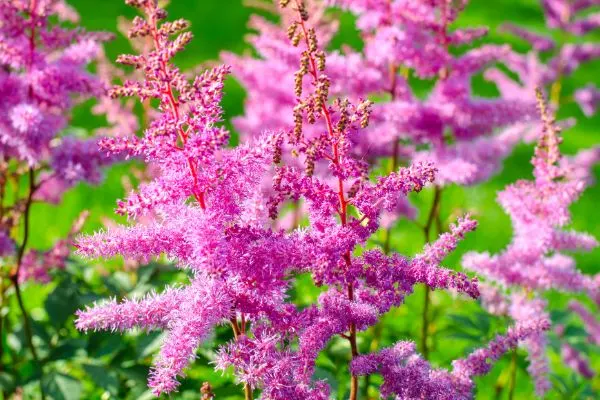
Astilbe is a genus of about eighteen (18) species of plants known as false goat’s beard or false spirea. They are flowering plants that belong to the family Saxifragaceae. Their flowers, which resemble feathers, are usually a shade of red, pink or purple.
Plants within this genus are native to forests and ravines in Asia and North America. They thrive in partial shade like ferns but they can also grow in full sun in cooler weather or climates. The soil requirements of these two kinds of plants are also similar.
False goat’s beards serve as very good companion plants for ferns in the garden. In addition to thriving in similar conditions to those that your ferns grow very well in, these plants have beautiful leaves and flowers that are very good complements.
Depending on what you need it for and what variety it is, a plant in the genus Astilbe can be planted at different spots for different purposes. It may be used as ground cover, grown in a plant pot, or used to shade your ferns a bit.
These plants grow very well beside ferns as both have similar needs and foliage, and Astilbe may be used for several purposes near your ferns.
2. Azaleas
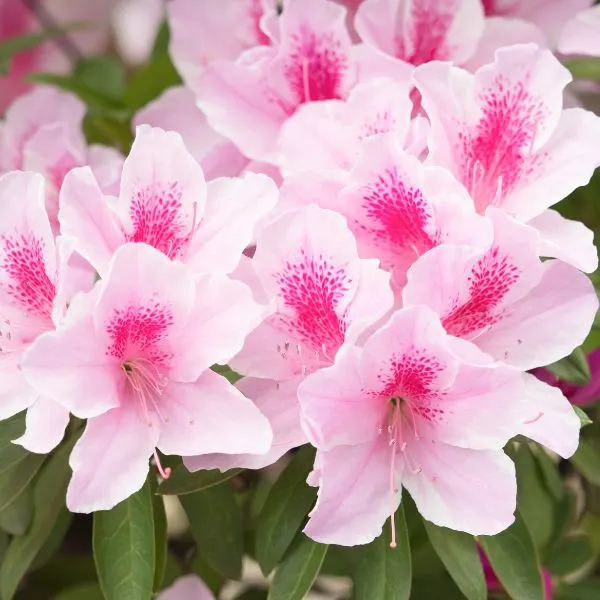
Azaleas are small- to medium-sized perennial flowering plants within the genus Rhododendron, which belongs to the heath or heather family Ericaceae. They have been bred for hundreds of years and thousands of cultivars also exist in azaleas.
These plants are native to Asia, Europe and North America, where they are cultivated largely for ornamental purposes. Azaleas produce very beautiful flowers which may be pink, red or any related shade of color.
They grow slowly, preferring to be cultivated in soil that is well draining, acidic and fertile (although they do not need too much fertilizer). They, much like ferns, love to grow in the shade: beneath trees and away from direct sunlight.
Azaleas serve as wonderful companion plants for ferns. They thrive around each other, as their needs are not different and demanding. Both plants are tolerant of the shade and love to be cultivated in moist, well drained soil.
It is imperative to plant ferns alongside other plants that have similar growth needs and beautiful flowers or foliage. This is because they add to the aesthetics of your garden without needing to make your ferns uncomfortable because of any substantial differences.
3. Barrenworts
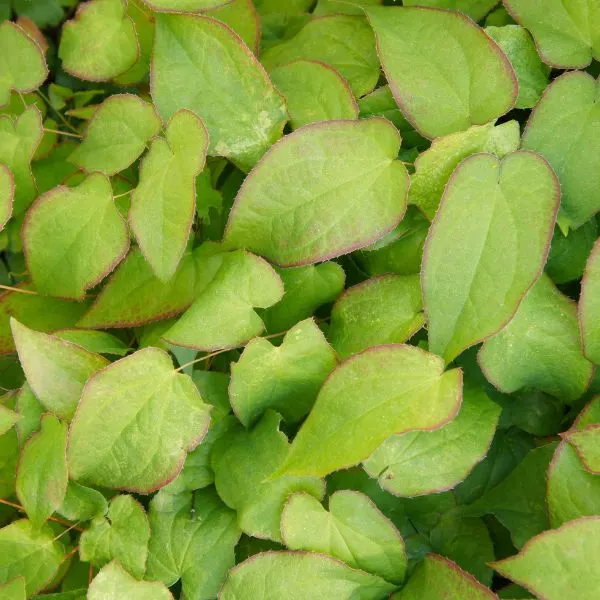
Barrenworts, also known as bishop’s hats, fairy wings, horny goat weeds or yin yang huo, are flowering plants of the genus Epimedium which belongs to Berberidaceae, the barberry family. Most species are only found in China while others may be found in Asia and around the Mediterranean.
They are perennial plants, deciduous or evergreen, which usually have flowers that are parted in four sections and may be said to resemble spiders when the plants are in bloom. Their flowers may be any shade of yellow, orange, white, pink or red.
Although most gymnosperms (plants like ferns that do not have flowers and thus reproduce using spores) are pollinated by the wind and so do not need the assistance of the pollinating insects that flowers attract, angiosperms (flowering plants) still serve as suitable companion plants.
Barrenworts, for example, are good companion plants for ferns as they make that area of the garden more beautiful and pleasing to look at. They are also comfortable growing in the conditions that ferns prefer.
Ferns and barrenworts both thrive in partial shade, although the latter can grow well in full sun as well. Barrenworts also serve as very good ground cover to retain soil moisture and their leaves, which may be green, blue, purple or burgundy are stunning too.
4. Bleeding Hearts
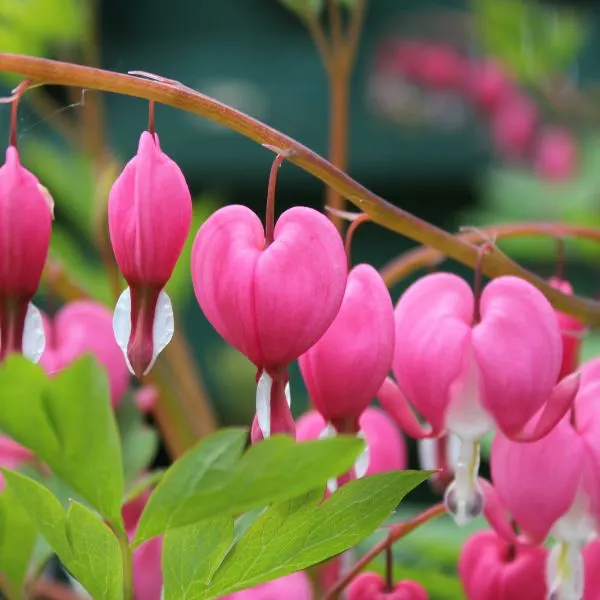
Native to Asia and North America, the flowering plants known commonly as bleeding hearts are any of the eight species in the genus Dicentra within the poppy family Papaveraceae. They are herbs known for their oddly shaped flowers and very distinct leaves.
Bleeding hearts have their flowers on leafless stalks, and these flowers are made up of two small sepals (the protective part) and four petals (the modified leaves directly covering the reproductive part). They are poisonous when eaten.
As a result of their origins in cool, wet and shaded forests in the northeastern parts of Asia, these plants thrive in shaded areas and love moisture. However, if they are excessively shaded or grown in soil that does not drain properly, they may not produce flowers or the best results.
Bleeding hearts are excellent companion plants for ferns and they have been so for a long time. The species in both genera like to grow under nearly identical conditions; they both appreciate the shade of taller plants and well drained soil.
The white and pink flowers of bleeding hearts, and their nice looking foliage which resemble that of ferns, tend to provide a beautiful contrast for, as well as complement the ferns in your garden. They are easy to grow, but should not grow in acidic soil.
5. Bluebells
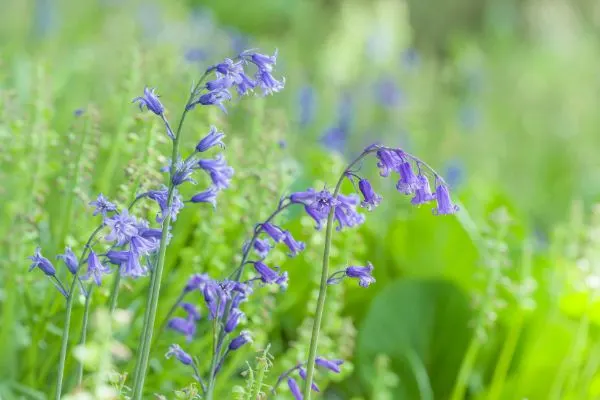
Common bluebells, simply known also as bluebells, are a species of perennial flowering plants that grow from bulbs (short stems with fleshy leaves or leaf bases that also serve as organs for storing food) in Asparagaceae, the asparagus family.
They are native to Europe and usually cultivated as garden plants. Bluebells bloom in the spring and produce some very beautiful, unique flowers. Their stems, which may grow up to 20 inches tall, droop or curve towards their apices.
Said flowers grow on one side of the nodding part of the stem and their tepals are usually a stunning violet-blue color. The tepals are fairly long and strongly curved backwards. Linear leaves grow from the base of the plant, usually between 3 and 6 in number.
Bluebells, with their gorgeous flowers shaped like bells, are very good companion plants for ferns when they are grown as garden plants. These plants are also tolerant of shade and prefer to be sheltered from full exposure to the sunlight.
When bluebells and ferns are grown together, that area of your garden is made to look even more beautiful as the violet blue color of the flowering plant’s flowers lend a pleasant contrast to the green foliage of the non-flowering plant.
6. Caladiums
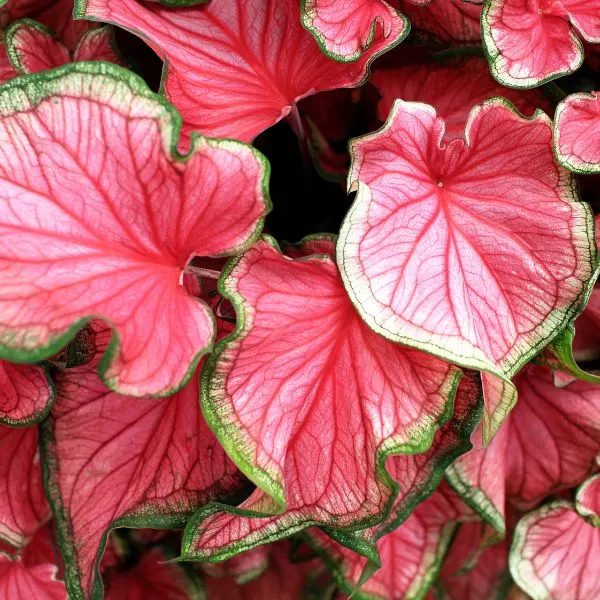
Commonly known as angel wings or elephant ears, these are any of the species of flowering plants in the genus Caladium within the arum family Araceae. They are native to South and Central America but may be found in parts of India, Africa and tropical islands.
Caladiums are usually grown for ornamental purposes. Their leaves are large and fancy, mostly shaped like arrowheads. These green, silver or burgundy leaves typically have patterns on them in the colors pink, red or white.
There are several cultivars and varieties of the species of Caladium. Most require watering in moderation, as they like their soil moist but not waterlogged. They love to grow under shade, be it partial or full, and many are grown indoors as houseplants.
They serve as very good companion plants for ferns. Like most other good companions, plants within the genus Caladium are very comfortable growing in the same areas or conditions as ferns, and they have beautiful foliage.
Colorful and patterned plants like these add character and vibrancy to your garden, as ferns usually look basic. You may want to plant your caladiums in pots that can be moved indoors as these plants are not very hardy (tolerant of extreme cold).
7. Coral Bells
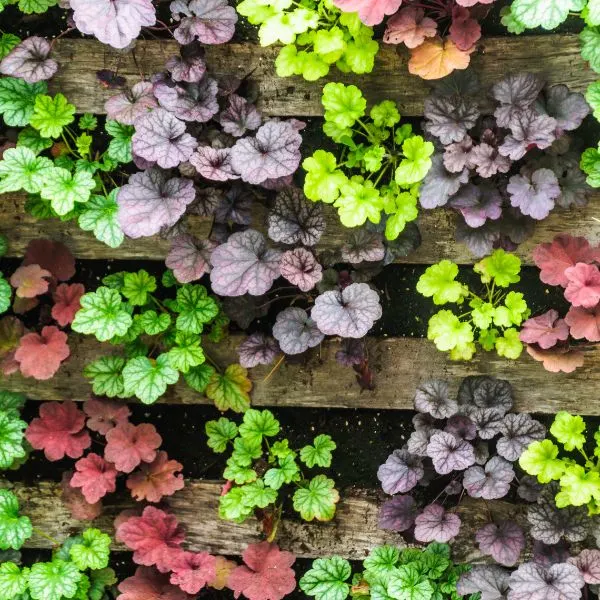
Commonly known as alumroot or coral bells, Heuchera is a genus of flowering plants in the family Saxifragaceae, like Astilbe. These largely evergreen perennials are all native to North America. About 37 species are currently known in this genus.
These plants produce orange, pink, red or white flowers that are attractive to bees. Coral bells contain tannins or tannoids, which are sharp or sour bitter-tasting chemical compounds. They are polyphenolic, gotten through plant-based foods.
Because of these tannins, coral bells are bitter and mostly free of pests. They prefer to grow under partial shade, more especially in warmer climates. Like ferns, they love to grow in moist and well draining soil.
Coral bells are good companion plants for ferns because they love the same growing environment, make the garden look more aesthetically appealing and protect your ferns from many harmful pests with their bitter foliage.
In addition to their small and beautiful flowers, the leaves that coral bells produce also come in various colors, like different shades of green, pink and purple. These round, hairy leaves last all year round but the plant may die out after a few years. Coral bells are drought resistant plants as well.
8. Corydalis
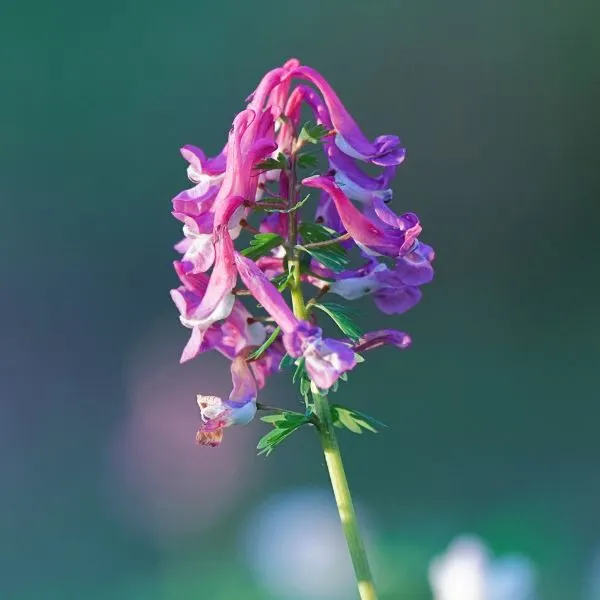
Corydalis is another genus of plants like bleeding hearts that belong to the poppy family Papaveraceae. They are native to temperate regions of the Northern Hemisphere and tropical mountainous areas of Eastern Africa.
There are close to 500 species within the genus Corydalis and these plants may be annual or perennial herbs. While some species are poisonous to livestock and may contain compounds that are toxic to the human body, some contain other compounds used to make medicine.
Corydalis plants thrive both in full sun and partial shade. They may grow in different types of soil, be it loamy, sandy or clay soil, with acidic, alkaline or neutral pH levels. Like ferns, they are hardy, growing well in conditions other plants may not survive.
They serve as good companion plants for various kinds of ferns. Although several species exist with their different looks, Corydalis plants are usually short and produce yellow, pink, blue, purple, white or light green tube-like flowers from drooping stems.
Besides being able to grow in shade-tolerant conditions like those your ferns appreciate, Corydalis plants act as good ground cover, retaining moisture within the soil. Their lovely flowers also serve as complements to the ferns around them.
9. Forget-Me-Nots
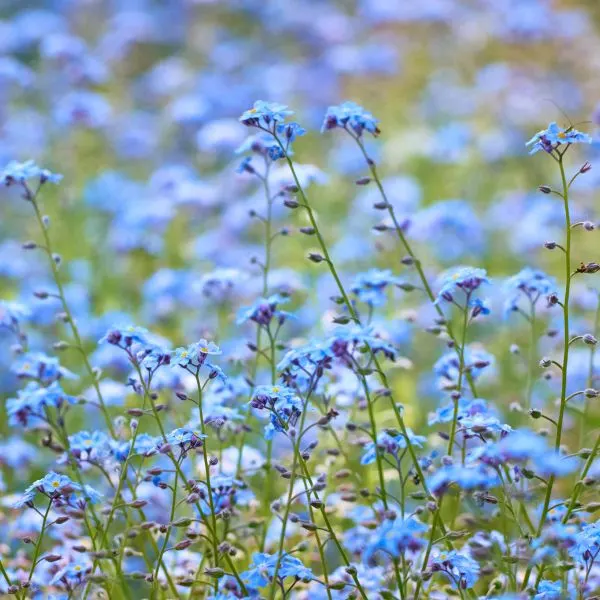
Forget-me-nots or scorpion grasses are species of flowering plants (angiosperms) in the genus Myosotis within the borage family Boraginaceae. Most species are found in Europe and Asia, although some are found in the continents of Australia, North America and South America.
These herbs may be annual or perennial, producing small, flat flowers which are usually blue, pink, white or yellow in color with yellow at the center. Their flowers typically bloom in the spring and they produce small seeds.
Forget-me-nots also enjoy humid weather, lots of moisture and partial shade. Thus, they are excellent plants to grow with or beside ferns in the garden. They are the most lovely in the spring when their flowers are in full bloom.
They may serve as ground cover in the garden to alleviate the problems of water loss, washing away of nutrients and removal of topsoil through erosion. This makes for a healthier garden ecosystem and improvement of the health of plants, including your ferns.
Like many other fern companion plants, they produce flowers that contrast the green leaves of the gymnosperm. They make for a colorful garden to ensure that pollinating insects still come to the area and aid the reproduction of flowering plants.
10. Geraniums
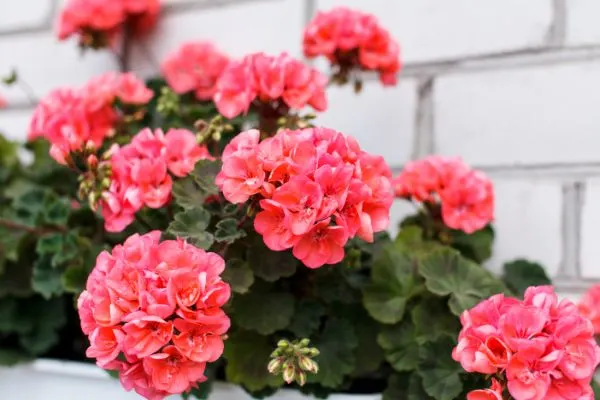
Geraniums or cranesbills are any of about 422 species of annual, biennial or perennial flowering plants that belong to the family Geraniaceae. They have beautiful flowers in a range of colors including blue, pink, purple and white.
Their moisture needs are not cumbersome. They require constant amounts of water in their earlier days and become drought resistant later on. They grow comfortably as long as the soil is not soggy or waterlogged.
Geraniums prefer to be watered when their soil has dried a little but the roots are not completely dried out. They are not cold tolerant and should be planted around times of the year when there is no longer a danger or risk of frost.
Taking care of these plants is quite easy. Be sure you have a sunny spot in your garden for geraniums as most species (save one) prefer to grow under direct sunlight. Your ferns should be properly spaced from geraniums and you may use mulch to retain some moisture within the soil.
When they blossom, geraniums may attract bees, butterflies and hummingbirds with their flowers. These pollinators aid the reproductive process of pollination in other plants. These plants also repel destructive insects like cabbage loopers, corn earworms, Japanese beetles, leafhoppers and wasps.
11. Heartleaf Brunnera
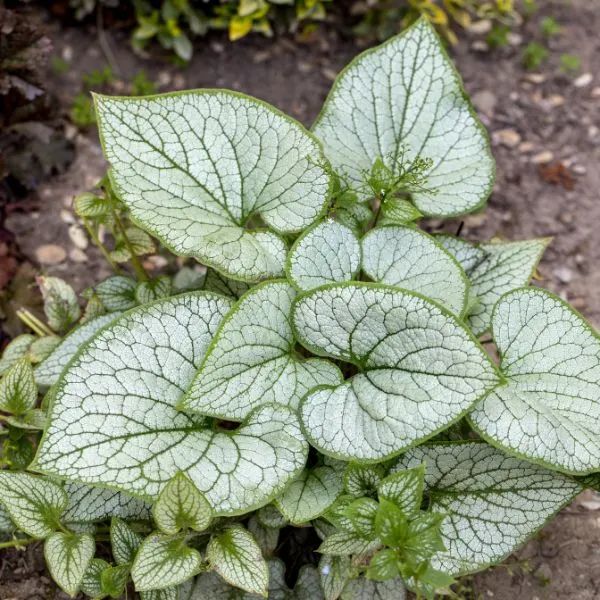
Brunnera is a species of flowering plants in the borage family Boraginaceae. It consists of perennial plants native to forests within Europe and Asia. Blossoming in the spring, they have hairy leaves and beautiful flowers.
The heartleaf brunnera, known as the false forget-me-not as well, produces lots of blue flowers in the spring that bear look like those of forget-me-nots. These plants grow low and serve as ground cover in the garden most of the time.
As their name suggests, they have heart-shaped leaves which are usually large in size and may be green, blue, gray or silver in color. Their leaves are also so hairy that they are able to keep pests away from the area.
Heartleaf brunnera species, also known as Siberian bugloss, great forget-me-not or large-leaf brunnera, is the most common species within its genus. It is very comfortable being grown under low lighting conditions, usually in partial shade.
In addition to being resistant to deer and rabbits, enjoying similar growing conditions and serving as ground cover to retain moisture in the garden, heartleaf brunnera is a good companion plant for ferns because it beautifies the garden. It is also very easy to maintain.
12. Hostas
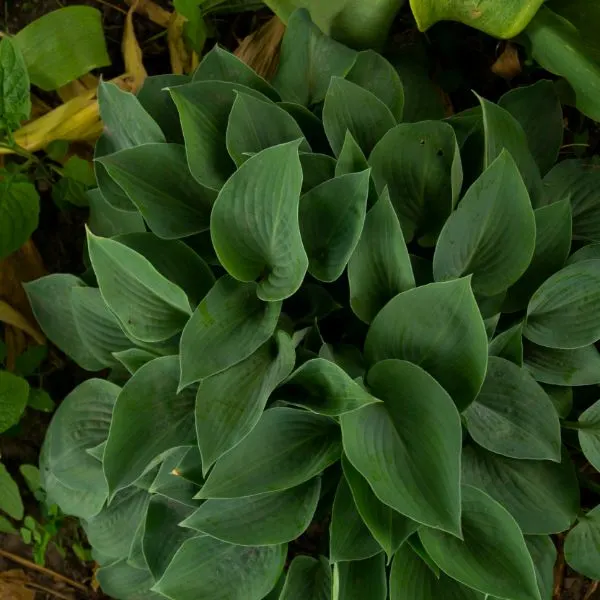
Hostas, also known as plantain lilies, are the monocotyledons in the genus Hosta which belongs to the biological family Asparagaceae. The plants in this genus were once classified under the family Liliaceae.
They are flowering plants, tolerant of shade and native to the northeastern part of Asia. Hostas have large, showy leaves that look very beautiful beside those of your ferns. The color of these leaves may be any shade of green, blue or yellow.
Hostas also produce stunning blue, purple or white flowers when they are in bloom and these complement the feathery leaves and look of the ferns nearby. In all, hostas are a lovely addition to your garden beside ferns because they improve the aesthetic of the area.
Also, because they are tolerant of shade and love moisture, hostas and ferns grow very comfortably around each other. Several sizes, shapes, colors and species of hostas exist and they may be planted in various ways near ferns.
Hostas are flowering shrubs that may grow up to 4 feet high and have large and flamboyant leaves. They may be paired with your ferns to improve the pleasantness of your garden to the eye, attract beneficial insects and avoid incompatibility which occurs when growing plants with very different needs.
13. Japanese Mahonia
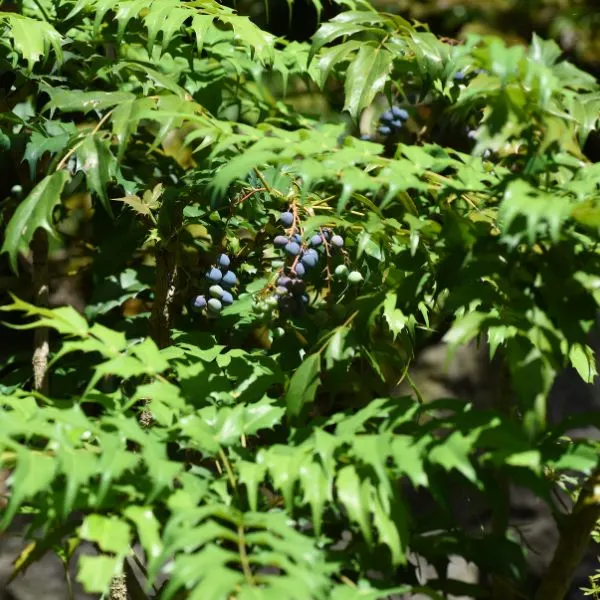
Japanese mahonia is a species in the genus Mahonia. This genus consists of about 70 species of mostly low growing flowering plants (and sometimes trees) in the barberry family Berberidaceae.
Plants in the genus Mahonia were originally found in Asia, North America and South America. They are mostly grown for ornamental purposes although they bear fruit in the spring or winter. They are evergreen plants.
The Japanese mahonia species is native to Taiwan but widely cultivated for use in Japan. It has feather-like or pinnate leaves which have a leathery texture or surface. The flowers it bears in the autumn, winter and spring are typically small in size and yellow in color.
Like other fern companion plants, Japanese mahonia acts as a ground cover on the floor of the garden because it is a shrub. It may also grow tall but it thrives in the shade and can be grown in a variety of soil types or conditions, much like ferns.
Color is added to the green foliage of ferns in the garden when Japanese mahonia is grown around them. The leaves which are evergreen, dainty yellow flowers and blue or black fruits make for a prettier garden and healthier ecosystem.
14. Leopard Plants
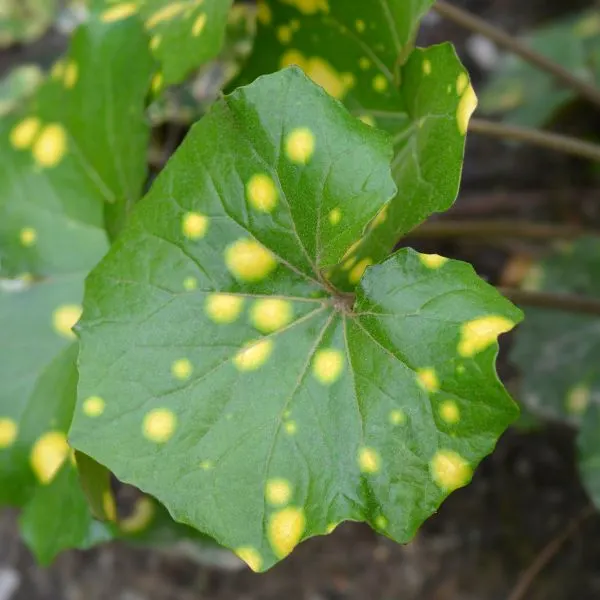
The plants commonly known as leopard plants are members of the genus Ligularia which belongs to Asteraceae, the daisy, aster or sunflower family. They are perennial herbs with origins in moist areas of Asia and Europe.
Leopard plants are so called because of the color of their flowers and stems. They typically produce yellow or orange flowers with brown or yellow in the middle and brown stems. Most species are cultivated for use as ornamental plants.
Plants within this genus Ligularia, because of their tropical or humid origins, love to grow in moist environments. They will comfortably grow in any type of soil provided that it holds moisture well but also drains properly. Their soil should not be overwatered and soggy.
They are very comfortable growing in the shade as well. Their orange, yellow and brown colors provide a certain form of contrast against the green hue of ferns in the garden bed. Leopard plants are good companion plants for ferns.
The companionship is very comfortable, as both plants may be grown in a variety of soil types. Leopard plants can also grow well in full sun but because they are shade tolerant and terns do not like direct exposure to sunlight, plant the pair in a shaded spot.
15. Other Ferns
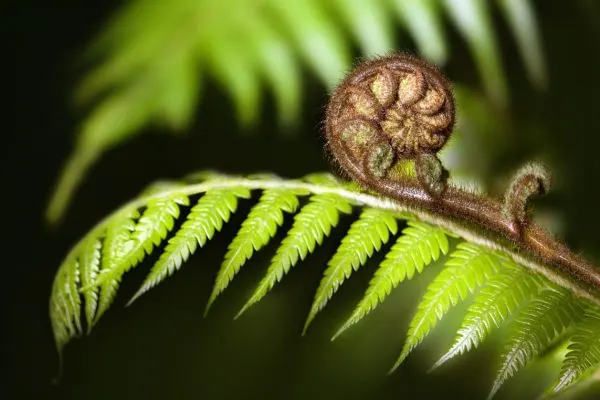
Another option for fern companion plants is to grow them near each other. Germs are generally tolerant of the same conditions and you do not need to worry about competition as long as they are properly spaced.
However, different fern species and varieties might have very different needs. While some might be drought resistant, in need of limited amounts of moisture, others may need more constant watering.
Some varieties prefer to grow in partial shade but others can grow in completely shaded areas. It is important to pair your ferns with other fern species that grow in very similar conditions and need about the same amounts of sunlight, shade and moisture.
Certain fern species are choosy about the environment in which they are cultivated but for the most part, ferns are hardy enough to be grown in many different conditions. There are no flowers on these plants but they do complement each or one another when planted in or around the same area.
16. Sedges
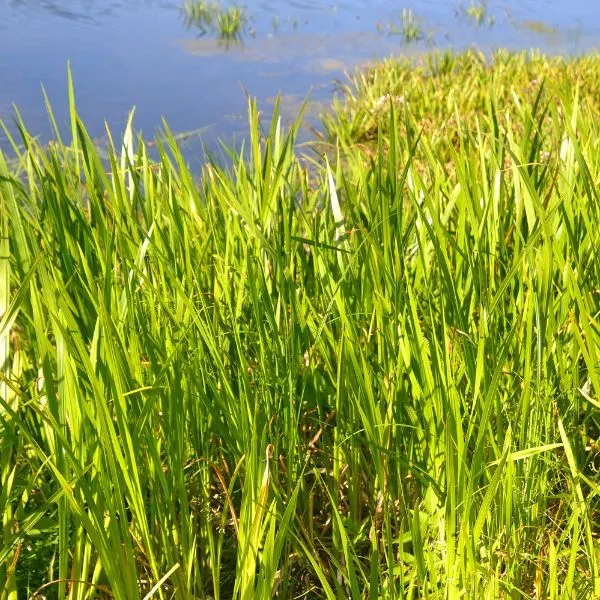
Sedges or true sedges are any of the 2,000 species of plants in the genus Carex. This genus, which is studied extensively in caricology, is within the large family Cyperaceae, often called the sedge family.
Plants that belong to the genus Carex are grass-like, known as graminoids. They are perennial plants but some species may bear fruits and die off after the first year of their lifespan. Their culms (stalks or stems) have very small flowers with no petals or sepals in the summer and autumn.
Like ferns, their reproductive process is done by means of the wind and not necessarily insects or animals. Sedges are like ferns in other ways; both genera have even more similarities like their growing needs.
They both prefer to grow in shaded areas, preferably under partial shade. They also do not like to be cultivated in dry areas as they need good amounts of moisture to thrive. Even though ferns do not have strict preferences when it comes to soil, sedges would rather grow in clay soil.
Sedges are mostly grown as ornamental plants in the garden. They complement the green foliage of your ferns with their brown, green or red leaves. They are ideal near ferns due to their corresponding growth needs and complementary looks.
17. Spiderworts
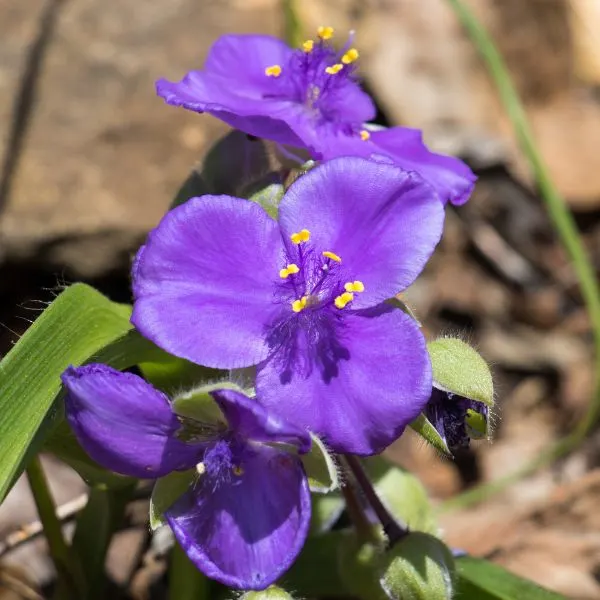
The genus of plants Tradescantia known more commonly as day flowers, inchplants, wandering jews or spiderworts is comprised of wildflowers which belong to the dayflower or spiderwort family Commelinaceae.
The perennial herbs are native to North America and South America but have been grown in several parts of Africa, Asia, Australia and Europe. There are currently 85 known species recognized within this genus, reaching between one foot and two feet in height on average.
Spiderworts have long and thin leaves, with small, dainty flowers. Their flowers may have three or four petals and may be blue, pink, purple or white in color. At the center of the flower, there are usually yellow anthers which may be six or eight in number.
Certain species have been observed to bear flowers for only one day. Spiderworts are good companion plants for ferns. They are easy to grow and maintain, and they share growing requirements or conditions similar to those that germs need.
Both plants prefer to grow in partial shade instead of full sun or full shade. For their soil, they both need varieties that can hold water well but drain properly too. They may be grown in soils with different ranges of pH levels so they are compatible when grown in close proximity to each other.
18. Spotted Dead Nettles

Purple dragons, spotted dead nettles or spotted henbits are flowering herbs of the genus Lamium in the mint family Lamiaceae. This species is native to Europe and temperate areas in the continent of Asia.
They are perennial crops that come in a range of leaf sizes, aerial length, leaf shapes, flower colors and plant hairiness. This means that while some individuals have hairy leaves, others have smooth leaves; while some have oval leaves, others have heart-shaped leaves.
Spotted dead nettles may grow to anywhere from 8 to 31.5 inches long. There are many individuals with spotted leaves and the leaves, spotted or not, usually have long stalks. They are fairly hardy plants that can handle exposure to light frost.
It is ideal to grow these plants alongside ferns in the garden. In their natural environment, they are mostly observed in the shade of taller plants and trees because that is where they like to grow. They thrive in partial and even full shade so they are good companion plants for ferns.
Just as a host of other fern companion plants do, spotted dead nettles give the added advantage of beautifying your garden space. Their flowers, which are predominantly purple or pink in color with white streaks, make your garden bed more aesthetically pleasing.
19. Strawberry Begonias
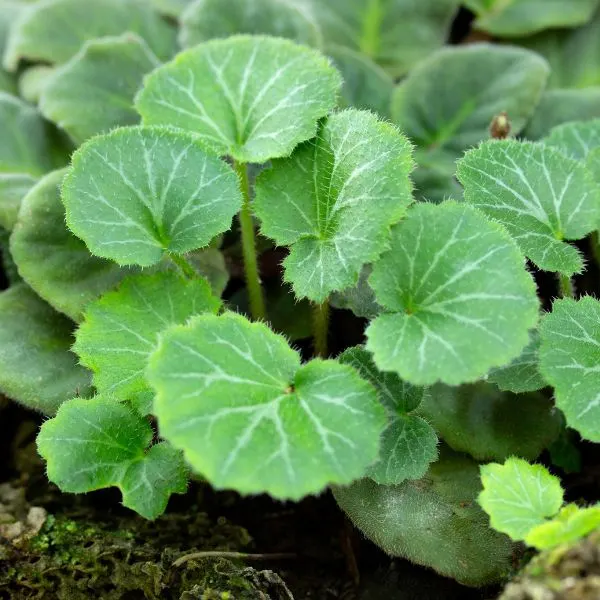
Strawberry begonias are perennial angiosperms that belong to the biological family Saxifragaceae. This species is one of the over 400 classified in the genus Saxifraga. It is native to China, Japan and Korea but can also be found in temperate regions of Europe and North America.
Also known as Aaron’s beard, creeping rockfoil, creeping saxifrage, mother of thousands, roving sailor, strawberry geranium or strawberry saxifrage, the strawberry begonia is used as an ornamental plant in several parts of the world.
In its natural habitat, it is found mostly in forests and bushes. It has red threadlike runners by which it spreads, possessing clones at the tips like in strawberry plants. Its rounded but almost heart-shaped hairy leaves typically are green above but silvery gray and red beneath.
Strawberry begonias produce red, white or yellow flowers in the summer and they are easy plants to care for with low maintenance needs. They are also shade loving plants so this makes them good as fern companions.
Their little, colorful flowers are very complementary, adding hue to the area. However, these plants are not very hardy. Consider growing them in a pot or separate container in order to move them indoors during colder months.
20. Wintergreens

This is another species in the heath family Ericaceae. Plants that belong to this species are commonly called American wintergreens, boxberries, checkerberries, eastern teaberries or simply wintergreens.
They are flowering plants native to the northeastern part of North America. They are also small shrubs that grow to about 4 to 6 inches tall. Like their name suggests, their leaves are evergreen, remaining green even in winter.
Wintergreens are used to produce wintergreen oil or oil of wintergreen and so they have the scent of this compound. Their bell shaped, drooping flowers which blossom in the spring and summer are mostly white but may have hints or streaks of pink.
They also produce edible, mildly sweet fruits (red berries) at maturity but only when they are grown under exposure to full sun. They prefer to be grown in soil with acidic pH levels and shaded environments like forests.
These plants provide contrast to your ferns and beautify the garden environment. Their small leaves are distinct from the large fronds of ferns, while their flowers add some color and more beauty lacking in ferns (because they do not produce flowers). They are very good companion plants for ferns.
Bad Companion Plants for Ferns
As we have highlighted above, it is important to take the needs and preferences of your ferns into consideration when looking for suitable companion plants. Plants that love to grow in similar conditions are generally good companions.
Ferns love to be grown in the shade and because they are native to warm, tropical areas most times where they are used to high humidity and rain, they also prefer their soil to be moist and well drained.
When these plants have beautiful flowers and inflorescences that contrast the green foliage of ferns (because they do not produce flowers), this is an added bonus because the garden looks more pleasant physically.
However, it is the similarity of growing conditions that is most paramount when choosing fern companion plants. For this reason, bad companion plants for ferns are generally those that cannot survive without exposure to direct sunlight.
Because ferns also love moisture and high humidity levels, drought tolerant plants may also be bad companion plants for some varieties of ferns. Some other species need less water to thrive and they may be planted with drought tolerant ferns.
Infographic
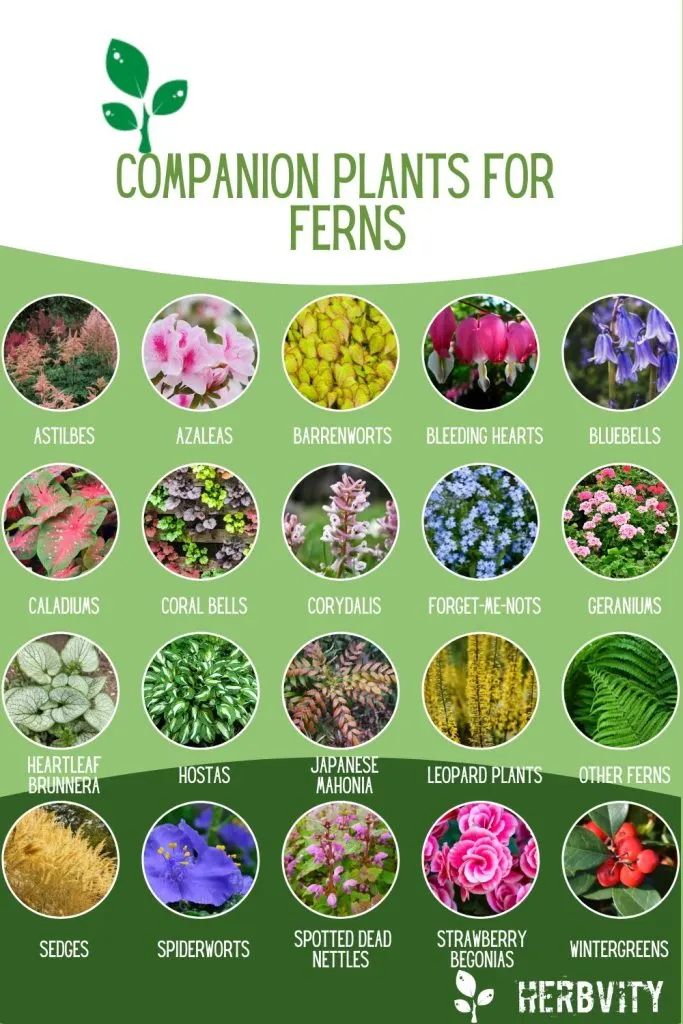
FAQs
What plants grow well next to ferns?

Several plants grow well next to ferns. Some of them are: Astilbe, azaleas, barrenworts, bleeding hearts, bluebells, Caladium, coral bells, Corydalis, forget-me-nots, geraniums, heartleaf brunnera, Hellebore, hostas, Japanese mahonia, leopard plants, sedges, other ferns, spiderworts, spotted dead nettles, strawberry begonias and wintergreens.
What do ferns like for fertilizer?
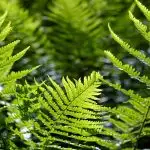
While ferns do not need fertilizer to grow healthy (especially perennial species), their growth may be aided by using aged compost and mulch as fertilizer.
What do ferns prefer?
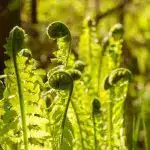
Ferns prefer to be grown in humid weather, in moist but well drained soil and with indirect exposure to sunlight (partial or full shade).
Conclusion
A fern is a vascular plant which produces neither seeds nor flowers, reproduces through or using spores, and has two tissues for the transmission of substances around the plant’s body. Listed and explained above are twenty (20) good companion plants for ferns.
Ferns contain good amounts of iron, magnesium, protein, sodium and vitamin C. Eating them helps control blood sugar, aids weight loss and reduces the risk of heart diseases and cancer.
While growing ferns, remember that they need exposure to indirect sunlight for the best or optimal results. This means they grow best under partial shade but some varieties are more shade tolerant.
Their soil must also be well drained and consistently moist. It does not need to be boosted with fertilizer but ferns can benefit from added compost and straw or chopped wood mulch. They grow well in a variety of soils but slightly acidic to neutral soil (pH of between 4.0 and 7.0) is usually best.
More plant stuff
